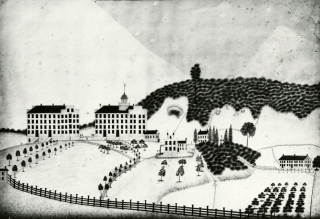freshman caps, attendance at cheer and song practice, and in general maintaining campus traditions, was taken over by the Sophomore Vigilance Committee in 1930. Paddling was a common punishment for violating the rules to be found in the Frosh Bible. By 1939 the senior honorary society, Konosioni, had assumed the duties of the sophomore committee.
Undergraduate support of the honor system had so declined by 1922 that on recommendation of the Students’ Association the faculty abolished it. Many undergraduates had come to believe that the crime was not so much cheating as being caught. Later college generations sought unsuccessfully to create sufficient public sentiment to revive the no-proctoring arrangements.
Interclass rivalry was a marked feature of student life in the ’20’s, especially between the Freshmen and sophomores, as had been true in the past. From time to time it was channeled into supervised events such as athletic competitions, the salt rush, and the pushball contest but the most violent encounters were likely to come when the classes held their banquets, usually off-campus, and before Moving Up Day in the spring. In 1923 they pelted each other in the center of the village with decayed eggs and the next year repeated the performance on two successive nights, on the second of which nearly the whole student body seems to have joined them. Irate businessmen with befouled storefronts and innocent bystanders who had been in “line of fire” demanded an end to such misbehavior and town and gown efforts averted it thereafter. The normal relations between students and merchants were very cordial and the latter were among the staunchest supporters of many campus activities, including athletics.
The undergraduate publications of the preceding years continued in the Cutten period. The Maroon editors by the middle ’20’s gave more space to non-athletic news items than formerly and in the spring of 1924 introduced “The Weeping Willow,” a column of comment and gossip which lasted until the fall of 1940 and at times gave considerable spice to the paper. The Salmagundi changed from a Junior to a Senior yearbook in 1934. Banter, the humor magazine, enjoyed the distinction of being suspended by the faculty in 1928 for publishing “objectionable” jokes. The literary magazine, The Willow Path, expired in 1931 for lack of support.
Dramatics made a strong bid for student attention. Russell F. Speirs, a Syracuse graduate in 1923, joined the faculty that year as a member





